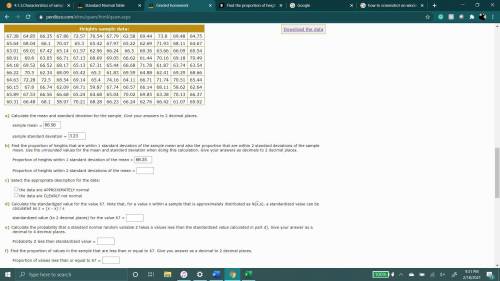
Mathematics, 19.02.2021 06:40 michaelswagout
Calculate the mean and standard deviation for the sample. Give your answers to 2 decimal places.
sample mean =
sample standard deviation =
b)Find the proportion of heights that are within 1 standard deviation of the sample mean and also the proportion that are within 2 standard deviations of the sample mean. Use the unrounded values for the mean and standard deviation when doing this calculation. Give your answers as decimals to 2 decimal places.
Proportion of heights within 1 standard deviation of the mean =
Proportion of heights within 2 standard deviations of the mean =
c)Select the appropriate description for the data:
the data are APPROXIMATELY normal
the data are CLEARLY not normal
d)Calculate the standardized value for the value 67. Note that, for a value x within a sample that is approximately distributed as N(x, s), a standardized value can be calculated as z = (x - x) / s
standardized value (to 2 decimal places) for the value 67 =
e)Calculate the probability that a standard normal random variable Z takes a values less than the standardized value calculated in part d). Give your answer as a decimal to 4 decimal places.
Probability Z less than standardized value =
f)Find the proportion of values in the sample that are less than or equal to 67. Give you answer as a decimal to 2 decimal places.
Proportion of values less than or equal to 67 =


Answers: 3
Another question on Mathematics

Mathematics, 21.06.2019 18:30
Abus travels 36 miles in 45 minutes. enter the number of miles the bus travels in 60 minutes at this rate.
Answers: 2

Mathematics, 21.06.2019 19:00
What are the solutions of the equation? 6x^2 + 11x + 4 = 0 a. 4/3, 1/2 b. -4/3, -1/2 c. 4/3, -1/2 d. -4/3, 1/2
Answers: 2

Mathematics, 22.06.2019 01:30
(01.03 mc) which of the following is a step in simplifying the expression x multiplied by y to the power of 2 over x to the power of negative 3 multiplied by y to the power of 3, the whole to the power of negative 4. select one: a. x to the power of negative 4 multiplied by y to the power of negative 2, the whole over x to the power of negative 7 multiplied by y to the power of negative 1. b. x to the power of negative 4 multiplied by y to the power of negative 8, the whole over x to the power of 12 multiplied by y to the power of negative 12. c. x to the power of negative 4 multiplied by y to the power of negative 8, the whole over x to the power of negative 3 multiplied by y to the power of 3. d. x to the power of negative 4 multiplied by y to the power of negative 2, the whole over x to the power of negative 3 multiplied by y to the power of 3.
Answers: 3

Mathematics, 22.06.2019 04:00
Will positive numbers always have a higher absolute value than negative numbers?
Answers: 1
You know the right answer?
Calculate the mean and standard deviation for the sample. Give your answers to 2 decimal places.
sa...
Questions

Mathematics, 10.12.2020 20:20




Mathematics, 10.12.2020 20:20

History, 10.12.2020 20:20




Mathematics, 10.12.2020 20:20

Mathematics, 10.12.2020 20:20

Physics, 10.12.2020 20:20

Mathematics, 10.12.2020 20:20


Mathematics, 10.12.2020 20:20

Mathematics, 10.12.2020 20:20

World Languages, 10.12.2020 20:20

Mathematics, 10.12.2020 20:20

Mathematics, 10.12.2020 20:20

History, 10.12.2020 20:20



